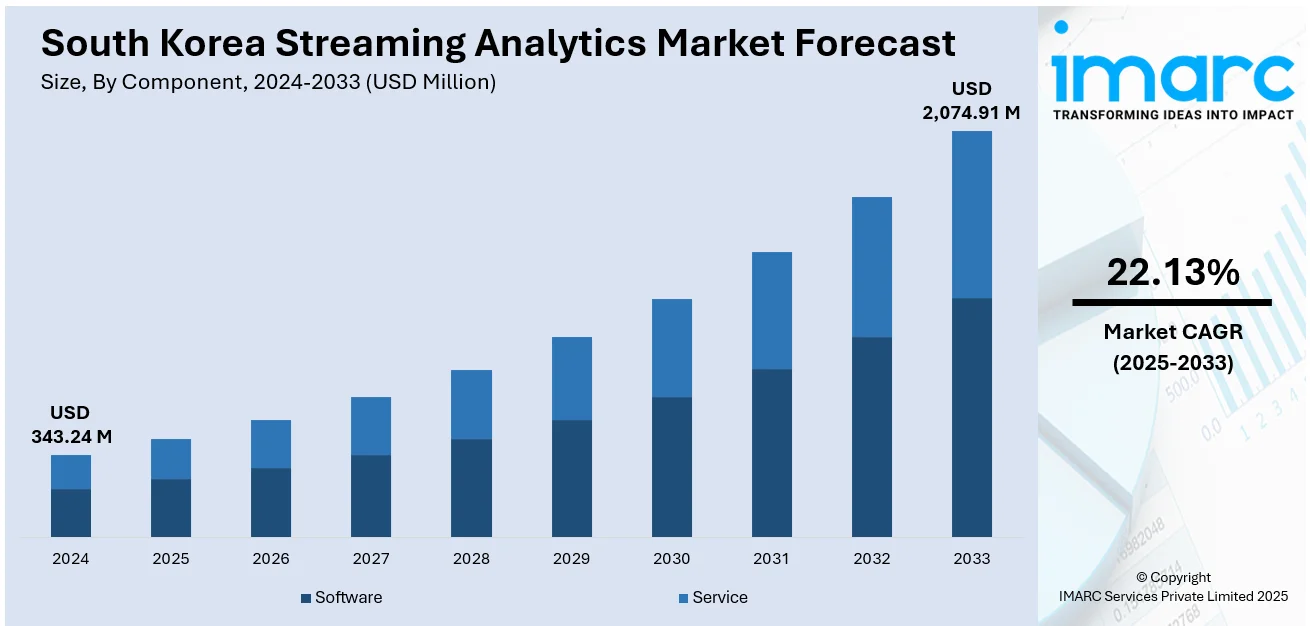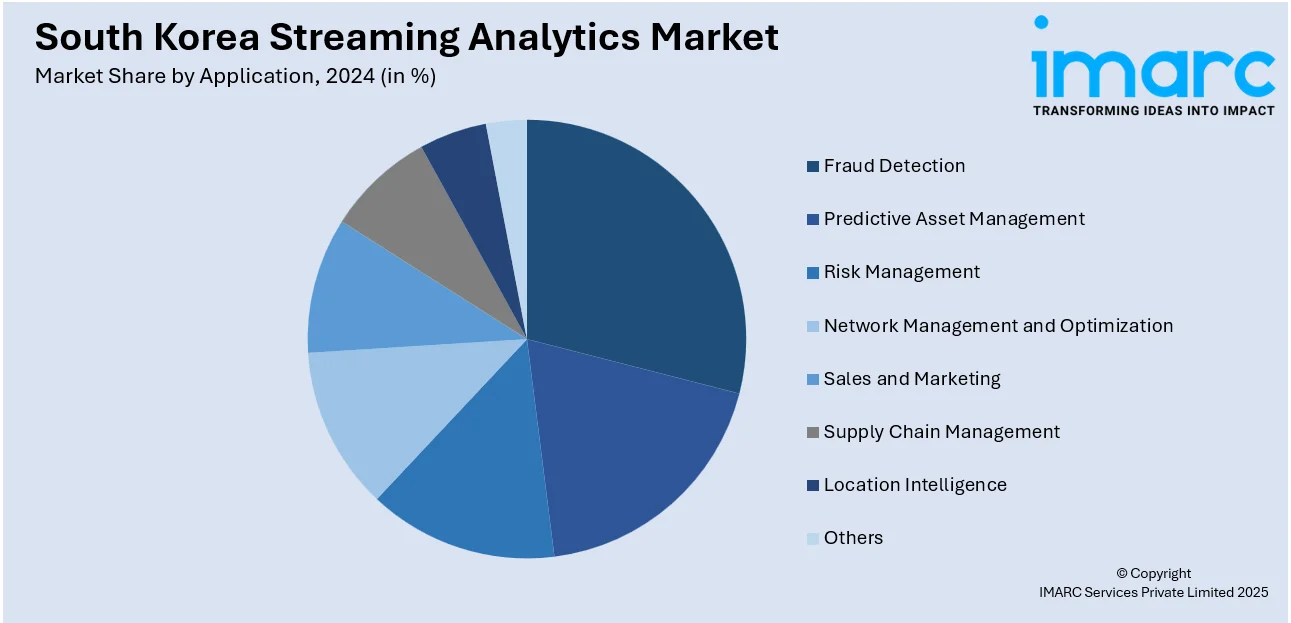
South Korea Streaming Analytics Market Size, Share, Trends and Forecast by Component, Deployment Mode, Organization Size, Application, Industry Vertical, and Region, 2025-2033
South Korea Streaming Analytics Market Overview:
The South Korea streaming analytics market size reached USD 343.24 Million in 2024. Looking forward, the market is projected to reach USD 2,074.91 Million by 2033, exhibiting a growth rate (CAGR) of 22.13% during 2025-2033. The market is driven by explosive growth in real time data from IoT, media, and telecom infrastructures that demand continuous insight. Enterprises across finance, manufacturing, and logistics sectors are now incorporating streaming analytics into core operations for risk management and performance optimization. A dynamic vendor ecosystem offering both global platforms and localized solutions, combined with flexible deployment models, is further augmenting the South Korea streaming analytics market share.
|
Report Attribute
|
Key Statistics
|
|---|---|
|
Base Year
|
2024
|
|
Forecast Years
|
2025-2033
|
|
Historical Years
|
2019-2024
|
|
Market Size in 2024
|
USD 343.24 Million |
|
Market Forecast in 2033
|
USD 2,074.91 Million |
| Market Growth Rate 2025-2033 | 22.13% |
South Korea Streaming Analytics Market Trends:
Proliferation of Real-Time Data from Connected Services
South Korea’s digitally advanced economy generates vast and continuous data from streaming sources such as telecommunications networks, smart retail systems, financial services, and media platforms. Industries require real-time insights into user behavior, network performance, and transaction flows. Streaming analytics fulfils this need by capturing, processing, and analyzing data in motion, enabling faster decision-making, fraud detection, and customer engagement strategies. Edge computing integration with mobile 5G services further amplifies processing speed and granularity. Smart city initiatives incorporate streaming analytics for traffic management, utility monitoring, and public safety alerts, making streamed event analysis a key tool for urban planners and service providers. As organizations seek to derive immediate value from transient data, they are investing in scalable platforms capable of handling millions of events per second. For instance, on July 8, 2025, South Korean streaming platform Naver TV secured exclusive broadcast rights to the Esports World Cup (EWC) for three years through its CHZZK service. The tournament features over 2,000 players from 200+ clubs across 100+ countries. This move highlights growing demand for esports content in South Korea and is expected to contribute to increased streaming activity and viewer data generation. South Korea streaming analytics market growth reflects this shift toward continuous insight generation, underpinned by the nation’s leadership in telecom infrastructure and IoT deployment.

To get more information on this market, Request Sample
Ecosystem Advancement and Vendor Innovation
A growing ecosystem of global and local streaming analytics vendors is fostering innovation and adoption among consumers. Recent industry reports show that Netflix continues to hold the top spot in South Korea’s subscription-based online video streaming services, with a 31% share of total subscribers. However, local platforms together make up a larger portion at 40%, with Tving at 16%, Coupang Play at 13%, and Wavve at 11%. International technology firms offer platforms with distributed processing, low-latency ingestion, and rich API support, while South Korean developers produce customized solutions with Korean-language interfaces, regional compliance features, and integration with local telecom and cloud providers. Partnerships between system integrators, cloud orchestration teams, and analytics software providers ensure streamlined deployment and domain-specific optimization. Add-on services, such as managed stream infrastructure, analytics-as-a-service, and real-time dashboard dashboards, enhance adoption across small and medium enterprises. Industry-specific modules, such as payment fraud detection, network traffic analysis, and smart factory monitoring, accelerate time to value. The availability of open-source frameworks and community-driven plugins further fuels experimentation and platform migration. As confidence grows in tried-and-tested solutions tailored to domestic market needs, subscription-based models and flexible pricing make streaming analytics accessible to a wider range of organizations, driving ecosystem depth and technology-led differentiation.
South Korea Streaming Analytics Market Segmentation:
IMARC Group provides an analysis of the key trends in each segment of the market, along with forecasts at the country and regional levels for 2025-2033. Our report has categorized the market based on component, deployment mode, organization size, application, and industry vertical.
Component Insights:
- Software
- Service
The report has provided a detailed breakup and analysis of the market based on the component. This includes software and service.
Deployment Mode Insights:
- Cloud-based
- On-premises
The report has provided a detailed breakup and analysis of the market based on the deployment mode. This includes cloud-based and on-premises.
Organization Size Insights:
- Large Enterprises
- Small and Medium-sized Enterprises
The report has provided a detailed breakup and analysis of the market based on the organization size. This includes large enterprises and small and medium-sized enterprises.
Application Insights:

- Fraud Detection
- Predictive Asset Management
- Risk Management
- Network Management and Optimization
- Sales and Marketing
- Supply Chain Management
- Location Intelligence
- Others
The report has provided a detailed breakup and analysis of the market based on the application. This includes fraud detection, predictive asset management, risk management, network management and optimization, sales and marketing, supply chain management, location intelligence, and others.
Industry Vertical Insights:
- IT and Telecom
- BFSI
- Manufacturing
- Government
- Retail and E-Commerce
- Media and Entertainment
- Healthcare
- Energy and Utilities
- Others
The report has provided a detailed breakup and analysis of the market based on the industry vertical. This includes IT and telecom, BFSI, manufacturing, government, retail and e-commerce, media and entertainment, healthcare, energy and utilities, and others.
Regional Insights:
- Seoul Capital Area
- Yeongnam (Southeastern Region)
- Honam (Southwestern Region)
- Hoseo (Central Region)
- Others
The report has also provided a comprehensive analysis of all major regional markets. This includes Seoul Capital Area, Yeongnam (Southeastern Region), Honam (Southwestern Region), Hoseo (Central Region), and others.
Competitive Landscape:
The market research report has also provided a comprehensive analysis of the competitive landscape. Competitive analysis such as market structure, key player positioning, top winning strategies, competitive dashboard, and company evaluation quadrant has been covered in the report. Also, detailed profiles of all major companies have been provided.
South Korea Streaming Analytics Market Report Coverage:
| Report Features | Details |
|---|---|
| Base Year of the Analysis | 2024 |
| Historical Period | 2019-2024 |
| Forecast Period | 2025-2033 |
| Units | Million USD |
| Scope of the Report |
Exploration of Historical Trends and Market Outlook, Industry Catalysts and Challenges, Segment-Wise Historical and Future Market Assessment:
|
| Components Covered | Software, Service |
| Deployment Modes Covered | Cloud-based, On-premises |
| Organization Sizes Covered | Large Enterprises, Small and Medium-sized Enterprises |
| Applications Covered | Fraud Detection, Predictive Asset Management, Risk Management, Network Management and Optimization, Sales and Marketing, Supply Chain Management, Location Intelligence, Others |
| Industry Verticals Covered | IT and Telecom, BFSI, Manufacturing, Government, Retail and E-Commerce, Media and Entertainment, Healthcare, Energy and Utilities, Others |
| Regions Covered | Seoul Capital Area, Yeongnam (Southeastern Region), Honam (Southwestern Region), Hoseo (Central Region), Others |
| Customization Scope | 10% Free Customization |
| Post-Sale Analyst Support | 10-12 Weeks |
| Delivery Format | PDF and Excel through Email (We can also provide the editable version of the report in PPT/Word format on special request) |
Key Questions Answered in This Report:
- How has the South Korea streaming analytics market performed so far and how will it perform in the coming years?
- What is the breakup of the South Korea streaming analytics market on the basis of component?
- What is the breakup of the South Korea streaming analytics market on the basis of deployment mode?
- What is the breakup of the South Korea streaming analytics market on the basis of organization size?
- What is the breakup of the South Korea streaming analytics market on the basis of application?
- What is the breakup of the South Korea streaming analytics market on the basis of industry vertical?
- What is the breakup of the South Korea streaming analytics market on the basis of region?
- What are the various stages in the value chain of the South Korea streaming analytics market?
- What are the key driving factors and challenges in the South Korea streaming analytics market?
- What is the structure of the South Korea streaming analytics market and who are the key players?
- What is the degree of competition in the South Korea streaming analytics market?
Key Benefits for Stakeholders:
- IMARC’s industry report offers a comprehensive quantitative analysis of various market segments, historical and current market trends, market forecasts, and dynamics of the South Korea streaming analytics market from 2019-2033.
- The research report provides the latest information on the market drivers, challenges, and opportunities in the South Korea streaming analytics market.
- Porter's five forces analysis assist stakeholders in assessing the impact of new entrants, competitive rivalry, supplier power, buyer power, and the threat of substitution. It helps stakeholders to analyze the level of competition within the South Korea streaming analytics industry and its attractiveness.
- Competitive landscape allows stakeholders to understand their competitive environment and provides an insight into the current positions of key players in the market.
Need more help?
- Speak to our experienced analysts for insights on the current market scenarios.
- Include additional segments and countries to customize the report as per your requirement.
- Gain an unparalleled competitive advantage in your domain by understanding how to utilize the report and positively impacting your operations and revenue.
- For further assistance, please connect with our analysts.
 Request Customization
Request Customization
 Speak to an Analyst
Speak to an Analyst
 Request Brochure
Request Brochure
 Inquire Before Buying
Inquire Before Buying




.webp)




.webp)












